Reviews
‘Relational Aesthetics’ Is Back at the Beyeler, Baby!
We finally know what the Fondation Beyeler's mysterious experimental summer show looks like—and it's great.
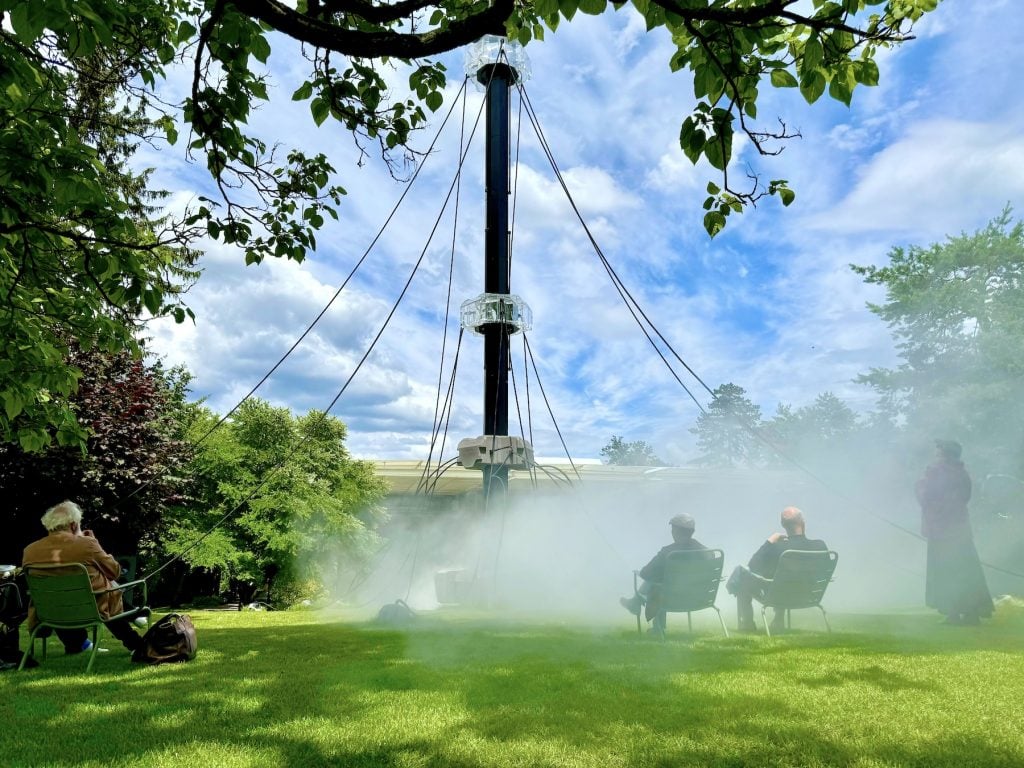
We finally know what the Fondation Beyeler's mysterious experimental summer show looks like—and it's great.

Ben Davis

Basel’s big museums tend to bring their best for Art Basel week, when the global art circus touches down in the placid Swiss berg. So, when the very biggest, the Beyeler Foundation, announced that its 2024 offering would be a group show, observers scratched their heads. Summer group shows are usually low-stakes placeholders. They don’t attract the buzz of a solo show celebrating a big name. To give you an idea of expectations, in 2023 the Beyeler brought out Basquiat; the year before, Mondrian.
Well, as it turns out, the Beyeler’s summer group show is getting plenty of buzz—enough, in fact, to legitimately be called “the talk of the art world.”
Observers are still scratching their heads though.
Because the show’s a weird one. It’s actually hard even to describe what it is. An experimental exhibition meant seemingly to inject novelty into every nook of the Beyeler, it is both over-stuffed with ideas and coyly under-explained—seemingly because the idea is to throw you off balance. Even the frickin’ title changes over time! It was being called “Dance with Daemons” when I was there, but is constantly renamed. A little accompanying booklet I picked up has a list of other titles including “Cloud Chronicles” and “The Richness of Going Slowly.” As I write this, the name online is “Echoes Unbound.”
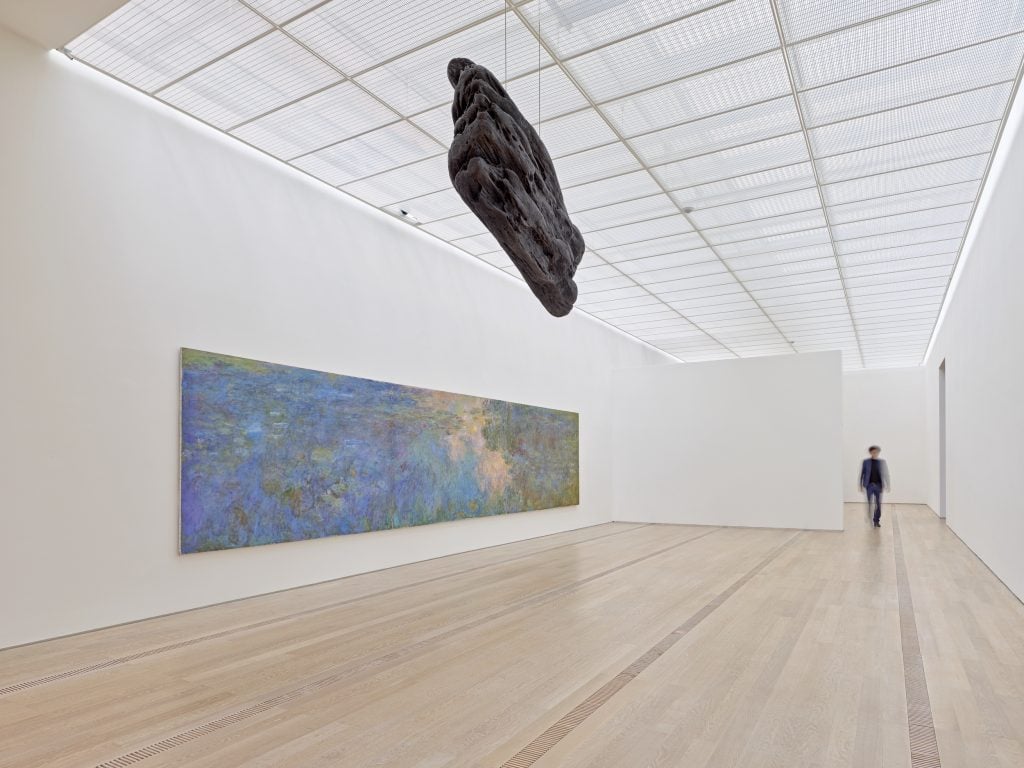
Installation view Fondation Beyeler, Riehen/Basel, 2024. Koo Jeong A, Boolgasaeu Boolgasali (2024). © Koo Jeong A. Photo: Mark Niedermann.
The show’s mission is “to stimulate artistic freedom, interdisciplinary exchange, and collective responsibility,” with its conception credited to no less than seven collaborators: Sam Keller, Mouna Mekouar, Isabela Mora, Hans Ulrich Obrist, Precious Okoyomon, Philippe Parreno, and Tino Sehgal. Instead of too many cooks spoiling the broth, it feels as if they have made some weird new flavor of exhibition—though it must also be said that this offbeat museum-as-living-thing brew is also just a throwback to the “relational aesthetics” moment that brought some of the bigger artists here to fame, when quirky science-project art and poetic scrambling of audience expectations were the rage.
Now that I think of it, if you wanted to state plainly what this show was “about,” it might be relational aesthetics nostalgia—Rirkrit Tiravanija offers the terrace as a space for cookouts, while Carsten Höller is offering a gallery in the museum to book for psychedelic sleepovers (there’s a holographic flying mushroom in the room). Nevertheless, for my money, the loose-limbed 2000s vibe feels suddenly fresh again, at a time when more market-driven art channels (galleries, fairs) aren’t really supporting much experimental work, and the less market-driven ones (museums, biennials) feel forlorn and at sea.
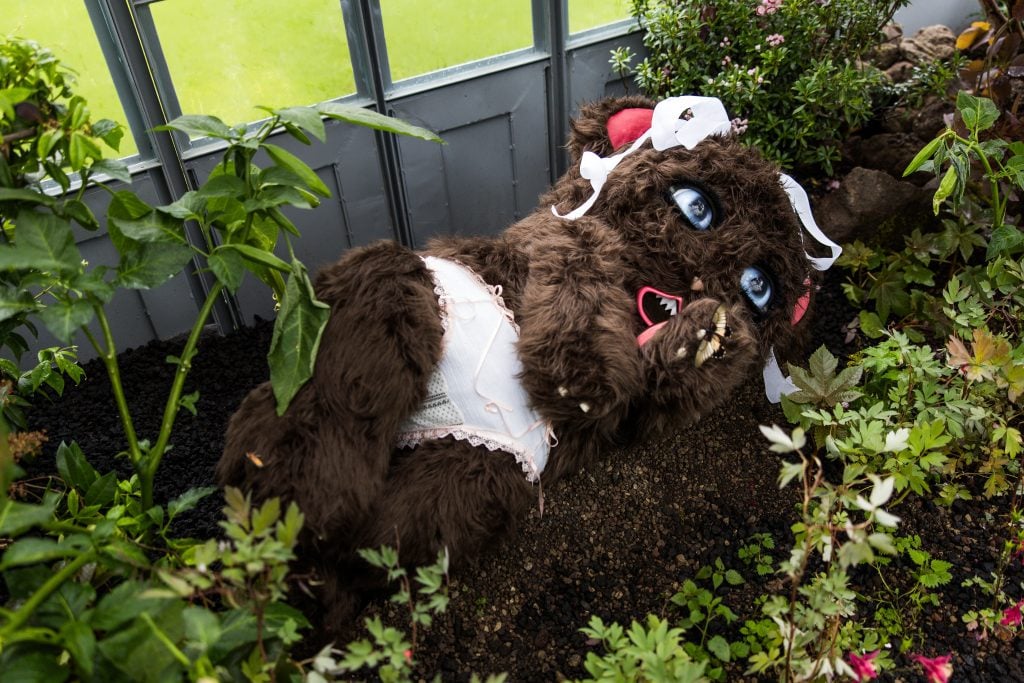
Installation view Fondation Beyeler, Riehen/Basel, 2024:
Precious Okoyomon, the sun eats her children (2024). © Precious Okoyomon. Photo: Stefan Bohrer.
Almost everything here challenges the audience to try to inhabit the museum in some kind of fresh way, engaging the senses as well as the brain. You’ve got a whole greenhouse-as-installation by Okoyomon, which is enchanting—there are butterflies!—but gets sinister when you realize it is all various poisonous flowers (there’s also an unsettling animatronic bear, like something out of Five Nights at Freddy’s). You’ve got Parreno’s techno-mythological tower, rising like some kind of alien artifact in the lawn, pulsing with movement and lights in an otherworldly way. You’ve got venerable Japanese artist Fujiko Nakaya’s “sculpture” consisting of jets of mist that are periodically unleashed, swamping the landscape around you. And that’s all before you even get inside the actual museum.
Within the tony galleries of the Beyeler, you discover that this contemporary art show is not, in fact, all about contemporary art. A big portion is devoted to showing off the famously astounding Beyeler permanent collection—but the curation has been helmed by Tino Sehgal, an artist known for staging “constructed situations” using performers in museums (he also has a charming performance work here, This Joy, featuring three dancers in shimmying, improvisatory formations doing semi-musical vocal riffs on Ode to Joy, among other tunes). True to form, Sehgal has turned his art curating into a performance: the installation is being remixed and rehung constantly so that you feel as if you are always in a show that is midway through being installed. You’ll see art handlers moving paintings often.
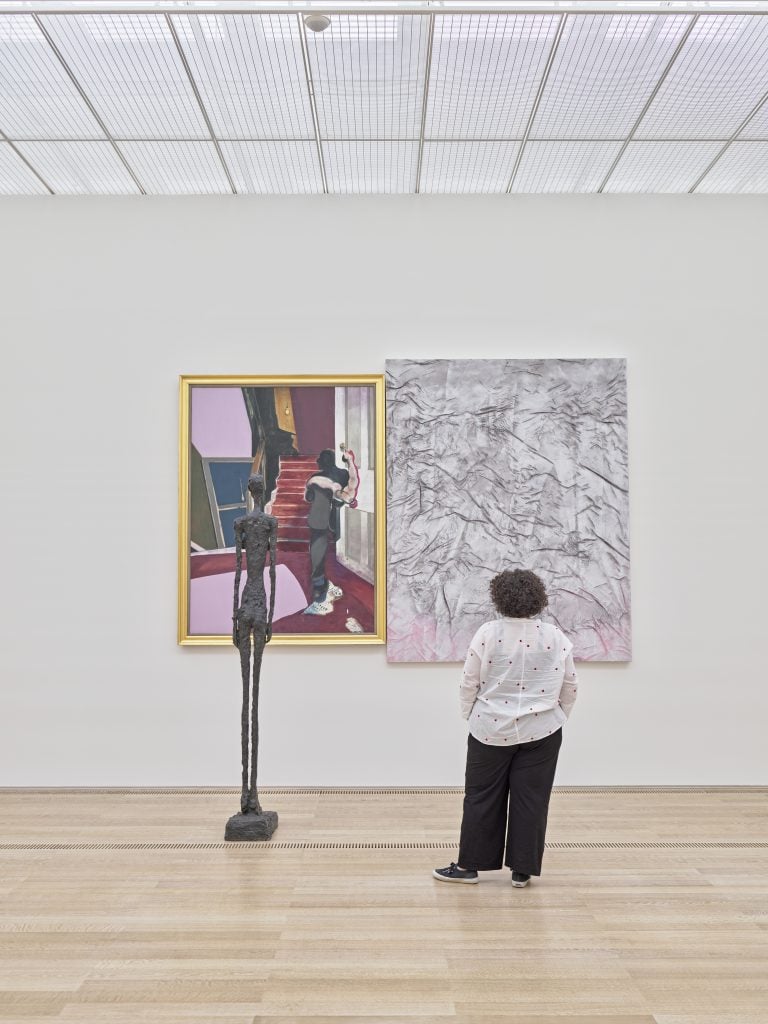
Installation view, Fondation Beyeler, Riehen/Basel, 2024 © Rudolf Stingel; Succession Alberto Giacometti; The Estate of Francis Bacon; 2024, ProLitteris, Zürich Photo: Mark Niedermann
When I passed through, Sehgal had placed highlights together in uncomfortably intimate, wonky proximity. An example: the central panel of a Francis Bacon triptych, hung cheek to jowl with a Rudolf Stingel abstraction, with a life-sized Alberto Giacometti figure placed as if it were staring into it. The gesture does make me viscerally feel why you don’t normally display art like this—what you gain in playful connections in the present you lose in focus on artists’ actual visions. But taken as an artistic performance, Sehgal’s curating is a truly memorable flex.
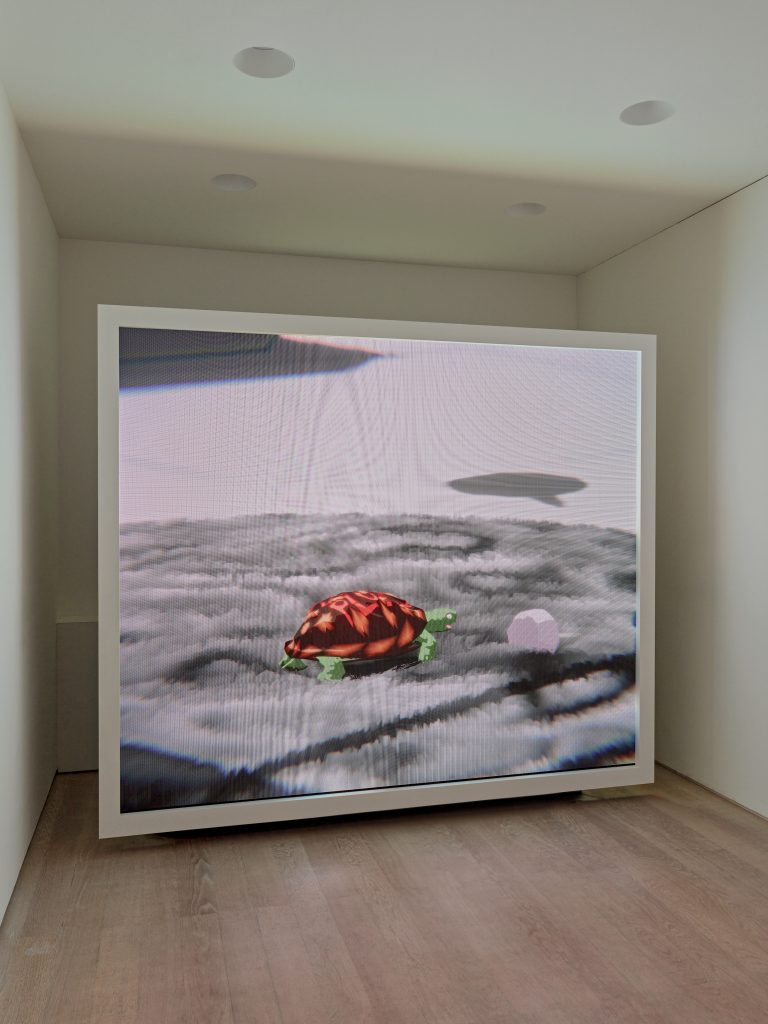
Installation view Fondation Beyeler, Riehen/Basel, 2024. Ian Cheng, Thousand Lives, (2023–2024) courtesy of the artist © Ian Cheng. Photo: Mark Niedermann.
There are little experimental flourishes everywhere, but the bulk of the contemporary part of the show is a more conventional, one-artist, one-room kind of thing. The chosen works are united by suggesting the possibility of unexpected experience and encounters, from an evolving A.I.-generated video of a turtle by Ian Cheng, to impressively weird sculptures that incorporate a washing machine and refrigerator by Adrián Villar Rojas.
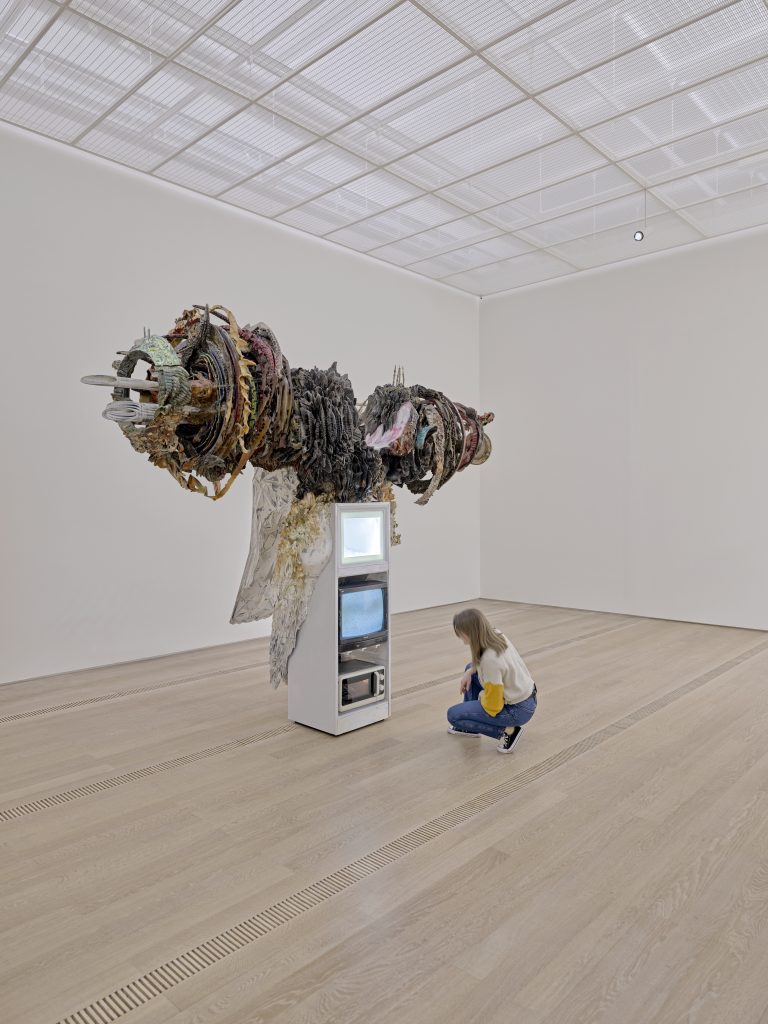
Installation view Fondation Beyeler, Riehen/Basel, 2024 Adrián Villar Rojas, The End of Imagination VII (2024), courtesy of the artist © Adrián Villar Rojas. Photo: Mark Niedermann.
It is not all jocular riffing. Arthur Jafa’s almost-abstract black-and-white film, LOML (2023), is a tribute to his friend, the late, great music critic Greg Tate, who passed in 2021. It is just fuzzy shapes, like a memory of some kind of powerful force being called upon, wrestling against oblivion. You might also sense here how the show’s larger spirit of playful juxtaposition can be salutary. For a work that could convey utter melancholy, the experimental context draws to the surface how the film’s ghostly, semi-abstract collage soundtrack has a warmth to it—the side of the work that is not just longing for a lost friend, but paying homage to the delight in musical invention that defined Tate’s writing.
I could name other highlights, but I’ll just end by mentioning the one that made me know I wanted to write about the show: Cyprien Gaillard’s Retinal Rivalry (2024), a half-hour 3-D film.
The danger of all this experimental interventionism is that it comes off as a gimmick, novelty for novelty’s sake. And 3-D is a perennial film gimmick. But like this show as a whole, Gaillard’s piece transcends that criticism with dispatch. Palpably the product of an artist with access to top-of-the-line tools and explicitly an exploration of their potentials, it is the best artistic use of 3-D I’ve even seen (and, yes, I am including the “space whale revenge” sequence from Avatar 2: The Way of Water).
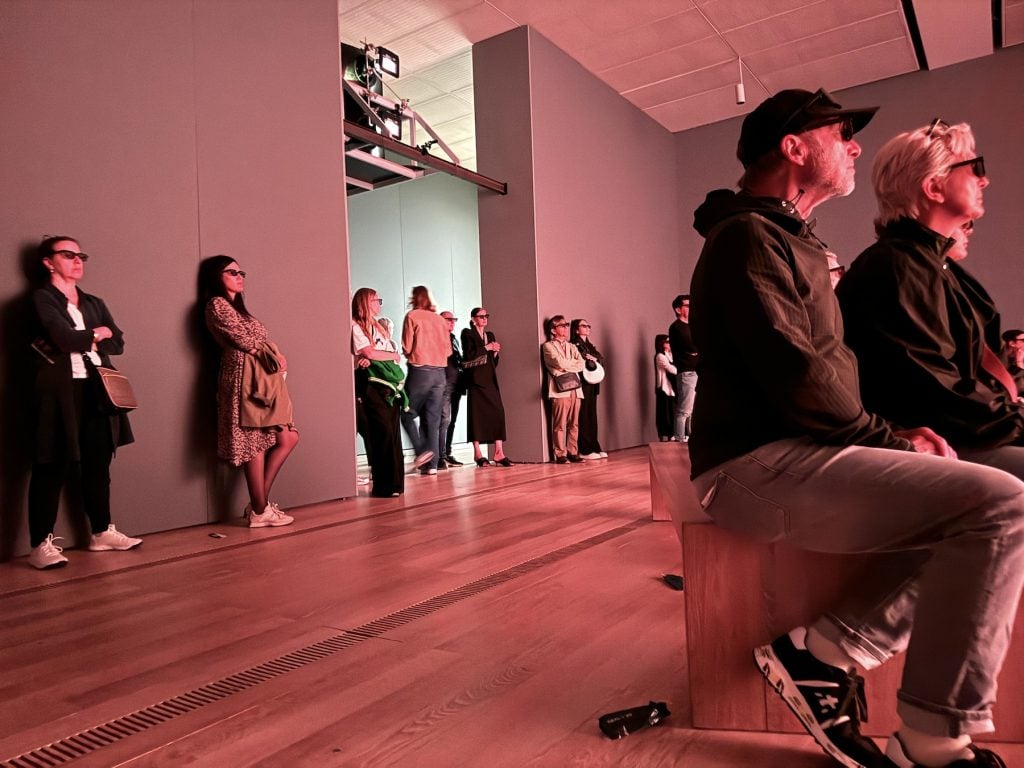
A crowd watches Retinal Rivals (2024) by Cyprien Gaillard.
Almost narrative-less, it takes us drifting across features of the German landscape and its monuments, often dwelling on the slightly cruddy sides of hallowed things: majestic buildings caked with construction scaffolding, dusty and neglected museum interiors, the dramatic views that inspired Caspar David Friedrich turned to tourist attractions. The imagery feels at once quotidian and meticulously composed, filmic paintings that use depth as one of their colors, putting 3-D’s jewel-box effect to work making you see what you are seeing in a new way.
At moments, the landscapes of Retinal Rivalry inspire a kind of dark awe about the scope of human impact on the world (the opening scene presses you up close to a huge-feeling mass of discarded glass bottles, only to watch them slither away from you as a chute opens, plunging into a dump far below—an extraordinary effect). At others, it made me chuckle (a shot centering on the giant, cartoonish nose of a sculpture, the camera moving in and out so that the schnoz looms at you comically). In still others, it gave an unexpected, visceral rush (the sequence that floats in on an outdoor wall plastered with Immersive Van Gogh posters, then plunges backwards along its length as if going into hyperspace—almost as if Gaillard were saying, “here, Immersive Van Gogh, let me show you how something really cool is done”). Like this entire experimental Beyeler exhibition, it’s a work of fluid connections, technical bravura, and a surprising emotional range.
The first of the two times I watched through Retinal Rivalry, a fellow viewer, a Swiss woman wearing a “RAISED BY THE STREETS” shirt-dress, was so distressed at how passive the audience was that she was telling everyone, “You’ve got to move around! The effect is better when you move around!” Helpful tip! As she exited, she said to her companion, “It’s really cool—but they haven’t realized it yet.” I feel like she was really getting into the spirit of this show.
The Fondation Beyeler’s summer show is on view in Basel, Switzerland, through August 11, 2024.